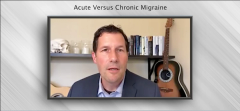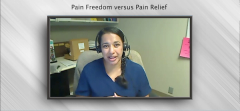
Acute Migraine Management: Overview and Unmet Needs
Episodes in this series

An expert in the management of acute migraine provides an overview of acute treatment and considers the various unmet needs in the space.
Wade M. Cooper, DO: The first question is about acute versus chronic migraine, and we like to separate those out. If someone has frequent migraine attacks, they are usually 4 to 72 hours. Moderate severe intensity, light and sound sensitivity, and nausea—those are the prerequisites, plus a couple of other features that help define migraines.
We know that if someone has migraine attacks that occur at a frequency that goes over 15 days per month of any kind of headache and more than 8 days per month of migraine, we call that chronic migraine. It has to happen for more than 3 months, but a lot of people make the mistake that chronic migraine is just someone who has had migraine for 10 to 20 years. To be more specific about it, it represents chronicity of migraine over the course of a month. It has to be more than 3 months with more than 15 days of headache, and more than 8 of those 15 days have to have migraine features attached to them.
It turns out migraine patients, many times, don’t get a correct diagnosis, and the American Headache Society has been working on this issue for decades. I remember when the triptan medications came out. There was a lot of energy focused on making accurate diagnoses, and unfortunately, as medical health professionals, we’ve barely moved the needle. We know about half the people out there who have migraine really don’t have the right diagnosis.
Many times, they’re told that they have a sinus headache or a tension headache. A clue is if someone says they had to stay home and were disabled from headache, they had to stop social plans, work plans, whatever they had going on, it’s most likely migraines, statistically speaking. Therefore, anyone who has recurrent headache and is missing time out of their lives, you should certainly suspect migraine.
Still, about 50% of the people in the United States just don’t have the right diagnosis out there. That leads to them not getting the right kind of care. We want people to have the right diagnosis, so they’ve got tools in front of them that we know can be effective.
When we talk about unmet needs, there are many in the migraine space. We first know that there’s a stigma with migraine. A lot of patients aren’t comfortable talking to their providers about migraine. A lot of migraine patients grew up in a migraine household, which means they’ve seen other family members cope with migraine without specifically identifying as such. Even if they know it’s migraine, they feel as if there’s no real hope out there. They’ve come to accept that they’re going to lose chunks of their day, taken away from them randomly, as a function of their migraine experience.
On top of that, we know that acute therapies out there aren’t always effective. For decades, people have used the NSAID [nonsteroidal anti-inflammatory drug]–class medications. Sometimes Ketorolac can be effective, but the over-the-counter acute medications are generally ineffective for moderate to severe migraine. Some people do quite well with over-the-counter medications, but if they use them frequently, we worry about medication-overuse headache syndrome.
When we look at the more commonly used prescription class medications, we know that the triptan-class medications, which had been remarkably effective for a chunk of people with migraine headache, don’t work for everybody. In a study published in 2019, a population-based study of more than 10,000 participants, we learned that triptans were not effective for at least 40% of people with migraine headache. That doesn’t include people who are willing to take triptans but have moderate effects or minimal effects. It also doesn’t include people who take triptans and feel sick from the medication, making them feel unwilling, or want them to delay their therapy, which can all be big issues for people with migraine.
With all these things put together, we know about 40% to 50% of migrainers aren’t getting the acute therapy they need and require. We also know that patient satisfaction with their current therapy—regardless of what it is—before the advent of these newer therapies was really high. About 90% of people who asked about their acute therapies would be willing to try something different, meaning only 10% of people said, “No, I’m good. I’ve got something that I like, that I trust in, that is effective.” Ninety percent of people with migraine are looking for better options, which is a huge statement.
Newsletter
Keep your finger on the pulse of neurology—subscribe to NeurologyLive for expert interviews, new data, and breakthrough treatment updates.














